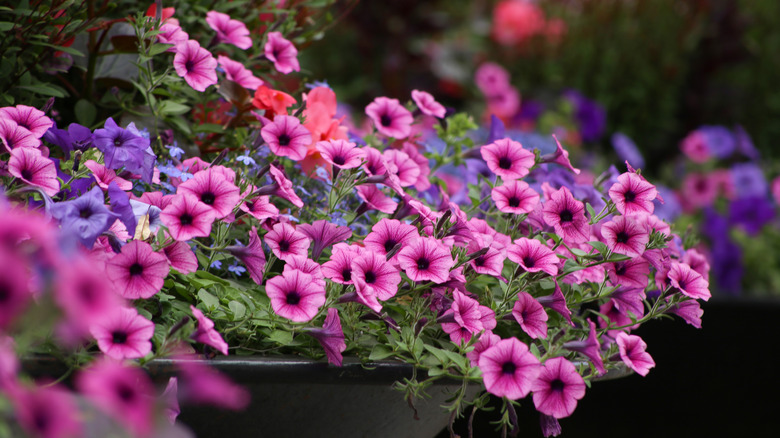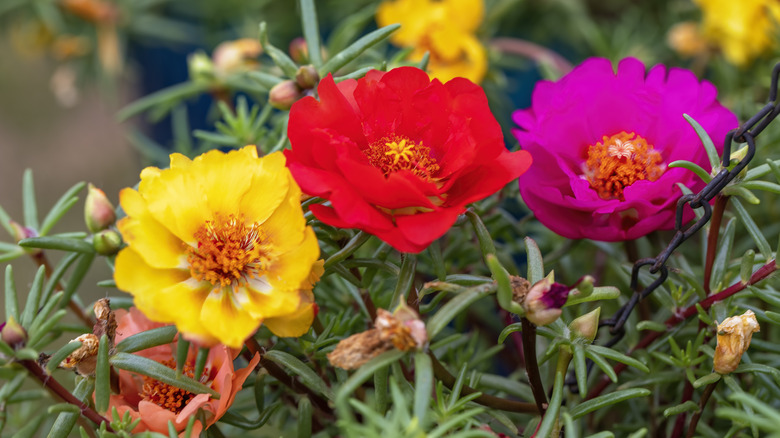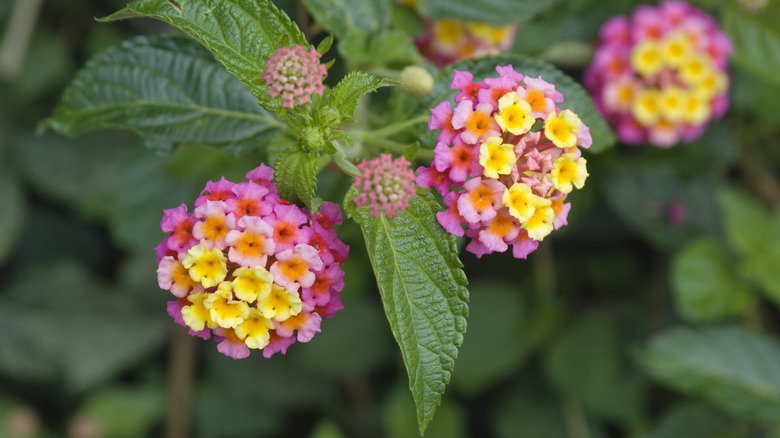13 Annuals That Will Flower From Spring Through Summer Once Your Peonies Have Faded
Peonies put on a glorious show in a mid to late spring garden, with a range of colors from pale pastels to dramatic, bright reds and pinks. But once this showy perennial's blooms fade, how can gardeners keep bright color going in the garden? Annuals are an excellent choice because they often bloom for weeks, and, with proper pruning and care, may even continue for months throughout the summer.
You can grow annuals in containers, including hanging baskets, or you can plant them right in the flower beds near your perennials. Some gardeners harvest the seeds from their summer annuals to plant the following spring; this works well with zinnias, cosmos, calendula, marigolds, and many others. Depending on your sun and shade conditions, there's a wide range of flowering annuals that bloom in sun, shade, or partial sun. Planting in containers gives you some flexibility for placement and lets you move them around.
Annual flowers are often from warmer growing zones, and tend to need frequent watering to stay vibrant in the summer heat. If they're in containers they should be watered daily. Deadheading spent blooms is also important, as many annuals will continue to form buds and keep flowering as long as the spent flowers are removed. Trimming the stems stimulates more growth and bud formation, keeping your annuals in bloom throughout the summer season and even into fall.
1. Petunias
Petunias are a versatile annual that come in trailing vine forms or shorter upright flowers. Their vivid colors and long bloom season make them a favorite for containers, especially hanging baskets or large mixed planters as a "spiller" that drapes over the edges. Petunias like sun, but can sometimes droop a bit in intense heat. They need regular watering to stay fresh looking, every three to four days (possibly more often in containers), and also benefit from frequent deadheading. "Wave" petunias are very popular for their large flowers and non-stop blooms.
2. Dahlias
Dahlias are perennial in warmer zones, but in colder zones the tubers must be lifted and stored for the winter. Some gardeners replant their dahlia tubers every spring, while others purchase them as annuals each year. These hardy bloomers should be pinched back before buds form in spring (similar to pinching back mums), so they will have fuller branching and more buds. Dahlias come in a wide range of colors and forms, with some shorter varieties perfect for containers, and taller ones that put on a spectacular show in the garden border.
3. Verbena
These small, delicate flowers with trailing, textured leaves are wonderful annuals for planters, hanging baskets, or flower beds. They keep blooming throughout the summer, as long as the spent blooms are deadheaded promptly. The range of colors is excellent, including pastel pink, peach, and lavender, and vivid bright shades of purple and red. They do best with frequent watering and prefer morning sun to afternoon sun to keep their blooms fresh looking. In the right growing zone they can be perennial, but are very popular as annuals.
4. Portulacas
These low-growing annuals are perfect for filling in pots and the front of the garden border. The spiky succulent leaves are vivid dark green and the flowers come in a vast assortment of colors, including pastels, brights, and two-tones. The "Happy Hour" cultivar features collections of mixed colors such as "Pink Passion" and "Tropical Sunset." These are fairly drought-tolerant annuals, and like a sandy, well-drained soil. Portulacas grow best in a garden location with at least six hours of direct bright sun per day. Portulacas may reseed in the garden and start emerging in early summer.
5. Marigolds
Marigolds are often thought of as being very "basic" flowers, more useful as an insect repellent planted next to tomatoes than as an ornamental container plant. But marigolds come in a wide range of colors (white to deep yellow, orange, and red) and provide a long season of bloom. Marigolds can be easily grown from seed or purchased as nursery plants. Snip off the spent flowers to encourage more buds and blooms. They love full sun and are not too fussy about soil. Water them when the soil surface is dry to the touch.
6. Zinnias
Zinnias are the classic sun-loving summer annual, impervious to heat, attracting pollinators, and providing colorful blooms well into early autumn. There is a wide variety to choose from: shorter varieties like "Lilliput" or "Cut and Come Again" to tall and stately "Oklahoma" or "California Giant." They grow well from seed — start them indoors and transplant outside after danger of frost has passed. Plant them so they're not too close together and with space between other plants: Good air circulation helps to prevent powdery mildew forming on their leaves. Zinnias make excellent long-lasting cut flowers.
7. Begonias
Wax begonias (also called strawberry begonias) are a great annual to plant in shade, but can also tolerate some morning sun. The colors range from white to pale pink to deep crimson, reminiscent of the cool colors of spring-blooming peonies. Begonias are easy-care annuals, needing a good rich soil and regular water. The waxy green leaves stay fresh and vibrant all summer, but they may get a bit scorched if they get too much bright sun. The flowers need only occasional deadheading to keep producing their delicate, colorful petals.
8. Celosia
These unusual flowers have feathery tufted clumps, with a velvety look and texture, in bright shades of yellow, orange, pink, purple, and red. Celosia do best in full sun, and prefer slightly acidic, well-drained soil. Some varieties have rounded, wavy-shaped tops but most are crested and come to a point. The fuzzy blooms rise above the stems full of bright green leaves, and make great cut or dried flowers for displays. Celosia often stay colorful and sturdy through the first frost. If the flowers fade, trim them off to stimulate new growth.
9. Impatiens
Impatiens come in two different types: shade-loving impatiens and sun-loving impatiens. SunPatiens are actually a hybrid of regular impatiens with a sun-tolerant patented variety. They have thick glossy leaves and slightly bigger flowers than shade impatiens. Shade loving impatiens have thinner leaves and can't tolerate bright sun without fading. Both types come in a wide variety of colors (white, brights, and pastels) and bloom for months, needing only light deadheading to stay fresh and vibrant.
10. Cosmos
With their threadlike leaves, featherweight petals, and daisy like tops, cosmos add a delicate beauty to the garden border. You can purchase the annual plants or grow them from seed in spring, then collect the seeds in fall to plant again. They come in single and double petal varieties in shades of white, pink, and crimson, with some yellow and orange varieties available. They need full sun and regular water. Some of the taller varieties are best grown at the back of the border or near a fence or wall for support.
11. Geraniums
Potted geraniums are a popular choice for summer annuals. Though red and white seem to be the most popular, the range of colors is huge, with shades of pink, peach, raspberry and violet. The Martha Washington cultivars feature two-tone colors that are real show-stoppers. There are also fragrant varieties available. These flowers benefit from frequent trimming of spent flowers to keep producing blooms all summer. Plant geraniums in containers or in the garden where they will get plenty of sun, but morning sun is better than afternoon to protect them from extreme summer heat.
12. Lantana
This tropical flowering vine is perennial in its native regions, but in colder zones it is grown as an annual. Grow lantana in containers or alongside perennials in the garden. The round flower clumps come in a range of colors, including a charming pink-yellow-orange combination, as well as white, purple, and deep red. They like full sun and need frequent watering to keep the soil moist. Trim spent blooms to keep the plant looking neat and encourage new buds. Lantana repels mosquitoes, but be aware this plant is toxic to humans and pets if eaten.
13. Sweet alyssum
Easy to grow from seed, low-growing sweet alyssum is also available as a potted annual from nurseries. Sometimes it will reseed in the garden, acting like a perennial. These tiny flowers bloom for weeks. Once the flowers fade, you can shear them back and wait for another round of bloom. The colors range from white to pale pink and lavender to dark purple. Sweet alyssum blooms will last longer if you plant them in a partially-sunny spot shaded from late afternoon sun. A bonus for this fragrant flower: It attracts many beneficial pollinators!













